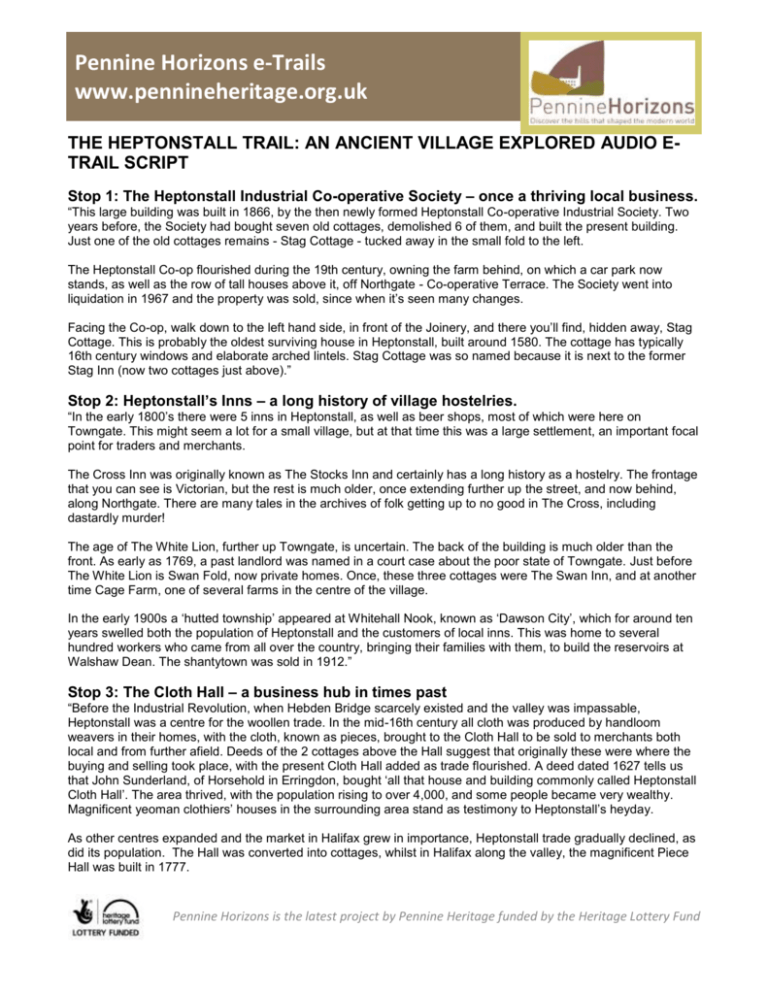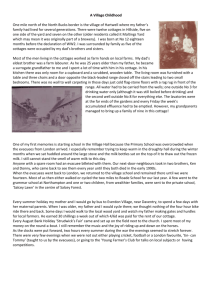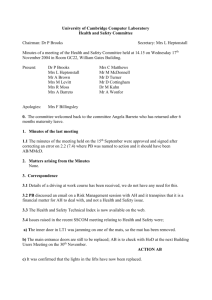the heptonstall trail: an ancient village explored
advertisement

Pennine Horizons e-Trails www.pennineheritage.org.uk P THE HEPTONSTALL TRAIL: AN ANCIENT VILLAGE EXPLORED AUDIO ETRAIL SCRIPT Stop 1: The Heptonstall Industrial Co-operative Society – once a thriving local business. “This large building was built in 1866, by the then newly formed Heptonstall Co-operative Industrial Society. Two years before, the Society had bought seven old cottages, demolished 6 of them, and built the present building. Just one of the old cottages remains - Stag Cottage - tucked away in the small fold to the left. The Heptonstall Co-op flourished during the 19th century, owning the farm behind, on which a car park now stands, as well as the row of tall houses above it, off Northgate - Co-operative Terrace. The Society went into liquidation in 1967 and the property was sold, since when it’s seen many changes. Facing the Co-op, walk down to the left hand side, in front of the Joinery, and there you’ll find, hidden away, Stag Cottage. This is probably the oldest surviving house in Heptonstall, built around 1580. The cottage has typically 16th century windows and elaborate arched lintels. Stag Cottage was so named because it is next to the former Stag Inn (now two cottages just above).” Stop 2: Heptonstall’s Inns – a long history of village hostelries. “In the early 1800’s there were 5 inns in Heptonstall, as well as beer shops, most of which were here on Towngate. This might seem a lot for a small village, but at that time this was a large settlement, an important focal point for traders and merchants. The Cross Inn was originally known as The Stocks Inn and certainly has a long history as a hostelry. The frontage that you can see is Victorian, but the rest is much older, once extending further up the street, and now behind, along Northgate. There are many tales in the archives of folk getting up to no good in The Cross, including dastardly murder! The age of The White Lion, further up Towngate, is uncertain. The back of the building is much older than the front. As early as 1769, a past landlord was named in a court case about the poor state of Towngate. Just before The White Lion is Swan Fold, now private homes. Once, these three cottages were The Swan Inn, and at another time Cage Farm, one of several farms in the centre of the village. In the early 1900s a ‘hutted township’ appeared at Whitehall Nook, known as ‘Dawson City’, which for around ten years swelled both the population of Heptonstall and the customers of local inns. This was home to several hundred workers who came from all over the country, bringing their families with them, to build the reservoirs at Walshaw Dean. The shantytown was sold in 1912.” Stop 3: The Cloth Hall – a business hub in times past “Before the Industrial Revolution, when Hebden Bridge scarcely existed and the valley was impassable, Heptonstall was a centre for the woollen trade. In the mid-16th century all cloth was produced by handloom weavers in their homes, with the cloth, known as pieces, brought to the Cloth Hall to be sold to merchants both local and from further afield. Deeds of the 2 cottages above the Hall suggest that originally these were where the buying and selling took place, with the present Cloth Hall added as trade flourished. A deed dated 1627 tells us that John Sunderland, of Horsehold in Erringdon, bought ‘all that house and building commonly called Heptonstall Cloth Hall’. The area thrived, with the population rising to over 4,000, and some people became very wealthy. Magnificent yeoman clothiers’ houses in the surrounding area stand as testimony to Heptonstall’s heyday. As other centres expanded and the market in Halifax grew in importance, Heptonstall trade gradually declined, as did its population. The Hall was converted into cottages, whilst in Halifax along the valley, the magnificent Piece Hall was built in 1777. Pennine Horizons is the latest project by Pennine Heritage funded by the Heritage Lottery Fund Pennine Horizons e-Trails www.pennineheritage.org.uk P The 3 storey building just past you, with railed steps, was once The Bull Inn, and later housed Heptonstall Working Men’s Club until 1972.” Stop 4: The Old Church – dedicated to St Thomas a Becket “The origins of this building are thought to be 13th century, though very little of the original remains. It was extended in the 14th and 15th centuries. The west face of the tower fell away in the great storm of 1847, but the church was still used until 1854, when building of the neighbouring new church was completed. The Old Church then rapidly fell into disrepair. Turn and look first at the tower; you’ll notice that it stands on a base of different stone –the 13th century base was added to in the 15th century, including battlements at the top. There’s a bricked up stair turret in the left hand corner. Now turn around and notice the Sanctus bellcote on the apex of the original gable end, in which a small bell would ring during Mass. A famous story goes that John Wesley preached here 5 times – but he was not impressed, and apparently said, in 1786, that Heptonstall Church was ‘the ugliest I know’. In its ruined state the church no longer warrants such a harsh judgement, and is worth a lingering moment or two. Carefully retrace your steps out of the porch back into the graveyard and look towards the bottom of the churchyard between the two churches. Notice the house with the gable end up to the churchyard’s edge and a weather vane on the chimneystack. This is Chantry House. It has a chequered history, at one time being a charnel house, where human bones were stored. It’s very unusual to have two churches in one churchyard. The graveyard around these two churches is said to hold the remains of over a hundred thousand bodies…this is impossible to confirm, though burial registers from 1594 to 1812 record over 25 thousand. Many gravestones have been used more than once, and there are medieval graves dating from before 1500 to be found. David Hartley, known as the King of Cragg Coiners, is buried here. He was hanged at York in 1770 for his part in a large scale counterfeiting conspiracy at Cragg Vale. His family and followers transported his body all the way back to be buried here. You can find out more in the museum about this exciting and dangerous time. To find the grave, count 12 stone slabs directly forward from the porch and two slabs to your left. The gravestone is inscribed ‘David Hartley 1770.’ You might want to explore more of the gravestones, and wonder at the stories they tell. “ Stop 5: The New Church – St Thomas the Apostle “The Church of St Thomas the Apostle was built after the extensive storm damage to the old church in 1847. Almost all of the stone used to build it was quarried from nearby Hell Hole Rocks. It was built quickly, begun in 1850 and finished in 1854, and is an excellent example of Victorian Gothic architecture. Take a look at the image of the new church taken over 100 years ago, clearly showing its structure within a treeless landscape. It cost £6,666 to build! The clock in the tower came from the old church, where it had been for 45 years. As well as for worship, this church is also the setting each year for the renowned Pennine Spring Music Festival, as well as other musical performances and events, having excellent acoustics. Follow the cobbled path to the left around the church towards its main entrance. Notice the reassembled pinnacle on your left – this fell from the tower above when struck by lightning in 1875. Take the path to the right through the South Gate, and cross the lane into the New Graveyard. The famed American poet Sylvia Plath, wife of Ted Hughes, is buried here. The land for this new burial ground was donated by Gamamiel Sutcliffe in 1911. His gift meant that the old burial ground around both churches was closed in 1915”. Stop 6: A Glorious Viewpoint “You are standing above Hell Hole Rocks now, where the stone for the Church was quarried, and where now rock climbers gather. To your left is the Upper Calder valley – notice how the road, railway and canal all cling together Pennine Horizons is the latest project by Pennine Heritage funded by the Heritage Lottery Fund Pennine Horizons e-Trails www.pennineheritage.org.uk P to connect the Pennines between Lancashire and West Yorkshire. Below, to the right, is the tributary Colden Water and its valley, packed with history and relics of early mills – another day, properly shod, you might like to walk E trail no 2 - Power in the Landscape. In the distance, on the 1300ft southern ridge of the Calder Valley, stands Stoodley Pike Monument- a 120ft stone beacon, erected in 1856. This replaced the previous wooden structure, which had been built to commemorate the end of the Napoleonic Wars in 1815 - but unfortunately collapsed in 1854 following a lightning strike plus decades of Calder Valley weather! The Rochdale Canal, the first across the Pennines, opened in 1804 and was a significant factor in the industrialisation of Hebden Bridge, making the valley passable, and the subsequent decline of Heptonstall. You will be able to clearly see Whiteley Arches, which carries the railway over the canal, river and road. For some years the canal company blocked early efforts to build a railway between Manchester and Leeds, but eventually the trans- Pennine line was completed, engineered by George Stephenson, and the first through journey made in 1841. The main valley road was once a Turnpike Road, with stagecoaches running to both sides of the Pennines in the early 19th century – slowly! “ Stop 7: The Mechanics’ Institution – “Man Know Thyself” – and Weaver’s Square “As you walk on along Church Street notice the large house immediately on the right – this was the Old Vicarage from the 1820’s until 1995. Long before that, it was the site of the Cock Pit, when fighting two birds together was regarded as sport. To your left you can see typical weavers’ cottages, with rows of upstairs windows to maximise light. A little further on, past an entrance to Weaver’s Square, you’ll find a stone tablet on the wall proclaiming The Mechanics’ Institution. This is an 18th century building which became the Mechanics Institution when moved from the old houses that had been demolished to build the Co-op in 1868. The object of the Society which met there was, to quote its rule book, ‘the instruction and improvement of its members’. Mechanics’ Institutes were an important part of life in Victorian industrial times - maybe similar to our adult education now, but usually for men only and probably far better used. Teaching was carried out on a voluntary basis, and the whole movement tells us a lot about the Victorian belief in education and self-improvement. In its heyday this Institution had a reading room and arranged lectures, but eventually became mainly a social club. Retrace your steps for a few yards and turn left into Weavers’ Square. Several weavers’ cottages and the old band room previously stood on this site – the Square was created around 1910 after their demolition, with the current Square completed in 1967, designed by a local architect. This was after West Riding County Council, rejected plans to turn it into a shopping centre! You can see that different materials have been used, some traditional, some modern. The stone well trough and mullioned window were preserved when demolition took place. Weaver’s Square is the centre of the village and is used for community events such as the famous annual Pace Egg Play every Good Friday, the Heptonstall Festival, and Christmas Carols. Leave the Square by the Towngate entrance, and take a look at the image on your phone – the building to the right of the boy was demolished, but the buildings shown on the left of the photograph remain - compare with now – not many differences!” Stop 8: Smithwell Lane from Top o’ th’ Town “Once again, this photograph of Smithwell Lane shows you that the view has scarcely altered in over 120 years, other than changes in fashion.. Pennine Horizons is the latest project by Pennine Heritage funded by the Heritage Lottery Fund Pennine Horizons e-Trails www.pennineheritage.org.uk P Walk up Smithwell Lane, pausing at Silver Street to your left (please do not enter). This is a row of former handloom weavers’ cottages, dated around 1800. One of the homes on Silver Street was for many years that of John Sutcliffe, who died in 1902. He was the last handloom weaver in the village, and one of the very last in all of the Pennines. As on Church Street you can see the windows on the upper floor, where the weavers worked all the daylight hours that they could, with other family members also working on the land or in service to supplement the meagre family income”. Stop 9: All Hands to the Pump “Before the days of piped water every village relied on its wells and pumps. This public pump, dated 1891, is one of the four that were used in Heptonstall. In times of drought, the pump would be locked and opened at specific times each day. The villagers queued for their water and would leave their empty cans in a line, upside down with their initials on the bottom, waiting for the pump to open again. There were also a number of wells, though some were contaminated and not used for drinking water. Because the bedrock is so close to the surface around here, some spring water wasn’t filtered well enough to be safe. As a result, for example, between 1843 and 1844, 51 cases of typhus- caused by polluted water - were recorded in Heptonstall and Slack, with 8 people dying. Later in the walk you’ll see an area of the village where there were several wells and one of the other pumps.” Stop 10: Fine Views Emphasise Heptonstall’s Position “Look to the west on your right, along the narrow saddle of Slack. This view emphasises Heptonstall’s prime position on its promontory. You will see the road divide a little further along at Slack Chapel - left to Colden, Blackshaw Head and the ancient Long Causeway to Burnley – right along the side of the Hebden Valley and Hardcastle Crags towards Widdop and Colne. As you walk back towards the village, notice the lane on your right down to The Ted Hughes Arvon Centre at Lumb Bank. This is an 18th-century mill-owner’s house which once belonged to Ted Hughes, former poet laureate, and whose parents at one time lived at Crown Point. Now the centre offers writing courses and retreats. A little further along you’ll see a stile in the wall to your right, from which a clear packhorse causeway (‘causey’) runs down and across the field - this links to E trail no ….The Packhorse Route from Blackshaw Head, which you may like to try another day - you would need proper walking shoes/boots for this walk.” Stop 11: Litherstone and Northgate “Facing you directly below the pub is a group of three cottages known as Litherstone, used as the Methodists’ ‘Preaching House’ from 1750 until their new Chapel was completed in 1764. John Wesley is believed to have preached from here, maybe speaking to the congregation below from the upper storey windows. Now turn left along Northgate to an ornate carved stone plaque inscribed 1736, depicting a male and female figure, above the second door on the left. Some believe that this was at one time a Quaker house. Carry on for a short distance to a left fork in the lane, spanned by a high stone lintel dated 1578. Walk up a little way to read the plaque on Whitehall farmhouse wall.” Stop 12: Heptonstall Methodist Chapel – the oldest in continuous use “This is the oldest Methodist chapel to have been in continuous use since it was built. It was designed as a preaching house in the shape of an octagon, the fashion of the time. Methodism had first come to the area in 1742 through travelling preachers William Darney and John Nelson. 5 years later Charles Wesley visited the area as well as his brother John and soon the first Methodist circuit was formed, with John Wesley regularly preaching Pennine Horizons is the latest project by Pennine Heritage funded by the Heritage Lottery Fund Pennine Horizons e-Trails www.pennineheritage.org.uk P here. The large crowds that John Wesley’s preaching attracted had resulted in the decision to build the chapel, completed in 1764. The views from the Chapel are breathtaking. Stop 13: The Pinfold and the Dungeon “In past times livestock that strayed from their owners’ land were impounded in the Pinfold until a fine was paid for their return. It is now a picnic area. Walk on through to the far end of the car park and look up to the right – the tall curved wall above you was once the wall of the brewhouse for the Stag Inn. Find the door in the bottom left hand corner – this guards a damp windowless cellar known as the ‘lock up ‘or Dungeon. This is directly below Stag Cottage, which you saw at the beginning of your journey. In earlier times petty criminals and drunks would be remanded here by the local constable. There is a record of the existence of an earlier dungeon elsewhere in the village in 1786. There was once a pump outside the Dungeon door as well as another- reputed to never run dry - inside the brewhouse. Carry on towards the exit of the car park. To your right, under an archway in the wall, is the wellhead, with a set of replica stocks.” At the end of the car park you’ll find yourself back where you began. Across the road The Post Office sells a variety of snacks and sweets, as well as local publications and souvenirs. Now take your pick of the local Tearoom or hostelries and enjoy well-earned rest and refreshments! Pennine Horizons is the latest project by Pennine Heritage funded by the Heritage Lottery Fund








